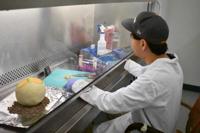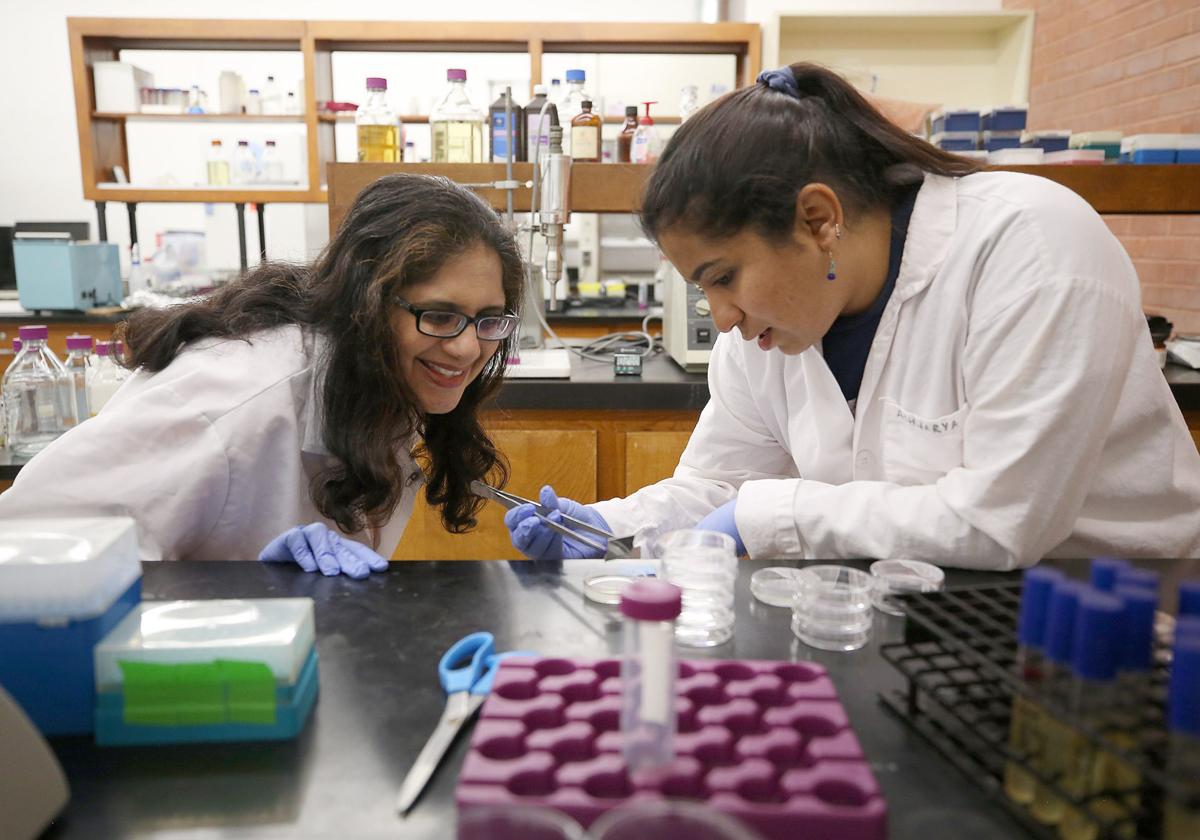Through research and collaboration with farmers, Ravishankar, an associate professor in the School of Animal and Comparative Biomedical Science, has shown that using essential oils, plant-based extracts and spice powders in a variety of foods can reduce or eliminate harmful bacteria, such as E. coli, salmonella and listeria.
Next on her docket: She and her University of Arizona team secured a $610,000 grant from the Specialty Crops Research Initiative, a program operated by the National Institute of Food and Agriculture.
With the grant, she and teams from seven other institutions aim to produce safer melons that do not harbor harmful bacteria while also improving the smell and taste of the fruit, said Paul Brierley, who will act as the link between the researchers and melon growers as executive director for the Yuma Center of Excellence for Desert Agriculture.
The total grant money awarded was nearly $4.5 million to Texas A&M and was shared among all other collaborating institutions. Ravishankar is the lead researcher from the UA and heads the food-safety portion of the melon project.

TARGETING MELONS
“One foodborne illness is too much,” Brierley said.
But in the last decade, melons caused more than 40 outbreaks of foodborne illness across the country, according to the Centers for Disease Control and Prevention. Half of the outbreaks were caused by cantaloupe.
The rough, netted rind of a cantaloupe can trap and prevent removal of disease-causing bacteria such as listeria and salmonella, even after washing and scrubbing. Slicing a melon drags any bacteria on the rind through the inner flesh that we eat.
One of the deadliest outbreaks of foodborne illness since the CDC began tracking in the 1970s took place in 2011. The outbreak was caused by listeria-infected cantaloupe from a Colorado farm. Out of the 147 reported cases, more than 30 people died.
“Listeria is dangerous for pregnant women and individuals with compromised immune systems,” Ravishankar said. “For those susceptible, the infectious dose can be very small. Even if there are only a hundred cells on the cantaloupe, these individuals can still get sick.”
Moreover, the majority of Arizona farmers do not sanitize cantaloupe in hot baths because the added moisture causes the fruit to mold quickly. Sanitizing is therefore left to the consumer.
Yuma is also one of the largest melon producers in the United States, second only to California and leads the nation in melon and other fruit production throughout the winter growing season, according to the U.S. Department of Agriculture.
Romaine lettuce is responsible for the latest outbreak of E. coli, which has sickened at least 98 people in 22 states, according to the CDC. The contaminated produce likely originated from a farm in Yuma.
Arizona produces more than 80 percent of the nation’s winter leafy greens, which contribute about $2 billion to the state’s economy a year, according to a UA report based on 2015 data.

PAST RESEARCH
Ravishankar has found that one of the most effective methods for ridding fruits and vegetables of harmful bacteria are natural sanitizers made from essential oils and plant extracts.
Essential oils have been known to have antimicrobial activity for a long time, but most research has been done in the lab with bacteria in a test tube, Ravishankar said. So she focuses her research on their effects on food, which is a much more complex medium.
“Food has fats, proteins, minerals and many other things that affect the activity of the antimicrobial compounds in essential oils and plant extracts,” she said, including oregano, cinnamon, lemongrass and clove bud oil, as well as olive, apple, grape seed, green tea, black tea and decaffeinated black tea extracts.
Additional hurdles include figuring out a way to dissolve essential oils in water. When successful, small quantities of natural sanitizer can be added to water to wash produce.
“Our idea is to use this instead of chlorine, which is not good for humans or the environment,” she said.
“When chlorine reacts with organic matter, it can form carcinogenic compounds.”
Even organic producers use tiny amounts of chlorine in their food washes. Ravishankar wants to remove chlorine from food contact and improve sanitizer effectiveness overall.
“You still see outbreaks, right?” she said. “Chlorine washes might not be as effective as some of the ones we are testing.”
Not only are these natural sanitizers chlorine-free, but they are also thought to have added benefits such as anti-diabetic, anti-cholesterol and anti-cancer properties, she said, adding that more research needs to be done before health benefits are confirmed.
GAME PLAN FOR CANTALOUPE
Texas A&M bred cantaloupe with a smoother rind, which might make it easier to keep bacteria-free. The Yuma Center for Excellence will test how successfully the new varieties of cantaloupe grow in the desert southwest, Brierley said.
The melons are already in the ground in Yuma and are also being grown in Texas, California, Florida, Georgia, North Carolina and Indiana.
Melons will be harvested around June or July, Brierley said. They might also plant a second crop mid-summer and harvest in fall to test a variety of growing conditions.
Ravishankar plans on applying the sanitizers using fog tunnels and electrostatic sprays to the new variety of cantaloupe as well as commercial cantaloupe, she said. Both methods use less water than the traditional hot baths.
EDIBLE PACKAGING
Another method she is considering to prevent foodborne illness is wrapping cantaloupe and other produce in edible films she’s developed.
These films are made of plant pulp. Essential oils that containing antimicrobial compounds are embedded in the pulpy film and diffuse throughout the food product. Films have been made from apple, carrot, tomato, spinach and hibiscus.
These films could potentially replace plastic packaging such as salad bags. Ravishankar has even tested her edible films on meat products including raw chicken and lunch meats.
“So if people like the flavor, they can eat it, because it’s healthy. It’s basically all plant. And if they don’t like it, they can remove the film and throw it out,” she said. “It’s food and it’s environmentally friendly.”
IN THE KITCHEN
Using small amounts of essential oil in water to keep fruits and veggies bacteria-free is also something you can do at home.
And don’t feel left out if you’re a meat-eater. There’s good news for you, too. Her research has shown that adding powdered spices to meats such as ground beef make it safer to consume.
For example, E. coli is found in the gut of cattle and can be spread to meat during the fray of slaughter.
One of her first findings was that adding common household spices such as garlic powder, onion powder or dried oregano to ground beef patties eliminates harmful bacteria more efficiently and at a lower temperature than needed without such spices. Other effective spices include ginger, turmeric, mustard, paprika and cumin.
The USDA recommends heating burger patties to 160 degrees Fahrenheit.
But adding powdered spices reduces the amount of dangerous bacteria at a lower temperature, which will not only help to maintain the texture, the color and the taste, according to Ravishankar, but will also help you to avoid over-cooking or burning parts of the patty.
Burnt meat contains carcinogens that can build up in the body over time.
If you do end up charring your burger a bit, she found that onion powder was best at reducing carcinogenic compounds.
“It’s so easy, I tell everyone, ‘When you’re making a burger, throw whatever spices you have in your spice rack. … Your beef patty could have a better flavor,’” she said.
This is also true for many essential oils and plant extracts.
“We were doing research and my student added olive extract to the patty and it smelled so good. People would pass by my lab and they’d say, ‘What are you guys cooking that smells so good?’”
TACKLING A GIANT
These are all simple changes that can make you safer and healthier. For Ravishankar, bringing these techniques to the larger food industry is much more intensive.
Ravishankar said this kind of research “easily takes 10 years.”
First comes basic research.
Each variety of essential oil has to be tested with each kind of fruit, vegetable and meat to see what’s most effective. Just because the essential oil worked against one bacteria on one food product doesn’t mean it will work with others.
She and her team must then replicate their results on a large scale. Once successful, they run sensory tests to ensure the flavor hasn’t been too altered and if consumers will actually want to buy the product.
Lastly, she has to prove that her method can be executed on a commercial scale.
It’s vital that food-safety researchers work closely with industry.
“You need a lot of resources and a lot of cooperation,” she said. “You can’t just rely on federal funding.”
But steering the giant food industry in a new direction is very difficult, to say the least, Ravishankar said. “It’s huge, and something has to be working really, really well.”
But her nonstop research is worth it, she said.
She has felt passionately about food safety since college and was motivated further by the Jack-in-the-Box E. coli outbreaks of 1993. Hundreds of people in four states were sickened, more than 170 were hospitalized, four died.
“You’re working on something for society, for the public. You’re making food safe that people want to eat every day,” she said. “It’s important that everyone has safe food to eat.”

